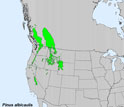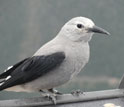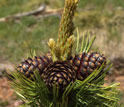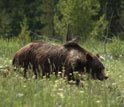News Release 13-101
Whitebark Pine Trees: Is Their Future at Risk?
Widespread tree death from beetle infestations, tree disease outbreaks affecting seed production
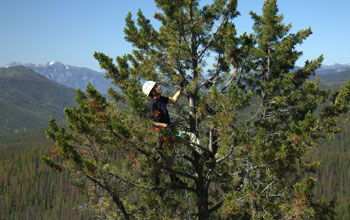
Ecologist Josh Rapp climbs a whitebark pine to sample cone-bearing branches.
June 10, 2013
This material is available primarily for archival purposes. Telephone numbers or other contact information may be out of date; please see current contact information at media contacts.
There's trouble ahead for the whitebark pine, a mountain tree that's integral to wildlife and water resources in the western United States and Canada.
Over the last decade, some populations of whitebark pines have declined by more than 90 percent. But these declines may be just the beginning.
New research results, supported by the National Science Foundation (NSF) and published today in the Journal of Ecology, suggest that as pine stands are increasingly fragmented by widespread tree death, surviving trees may be hindered in their ability to produce their usually abundant seeds.
"With fewer seeds, you get less regeneration," says ecologist Joshua Rapp, affiliated with NSF's Harvard Forest Long-Term Ecological Research (LTER) site and lead author of the paper.
Whitebark pine populations vary between producing a high number of seed cones some years, and a low number of seed cones other years.
This variation depends on four factors: male pollen cones, female seed cones, wind and proximity.
Each year, pollen from male cones is carried on the air to fertilize female seed cones perched atop nearby trees.
"In low-cone years, less pollen is released, reaching extremely few female cones," says Elizabeth Crone, senior ecologist at the NSF Harvard Forest LTER site and co-author of the paper.
"But as more and more whitebark pines die, every year becomes a low-cone year."
In isolated pockets of trees, the gene pool is also diminished, meaning the seeds produced may be less viable over time.
"For decades, researchers have struggled to understand why many different organisms--trees, fish, corals, insects--from various habitats reproduce synchronously and at certain intervals," says Saran Twombly, program director in NSF's Division of Environmental Biology, which funded the research.
"By combining field data on seed and pollen production for whitebark pines with models that simulate mature cone production, this study helps to answer that question for these pines."
To reach their conclusions, the scientists had to look back in time.
They inspected branches from seven whitebark pine sites in western Montana, counting the scars left by pollen cones and seed cones.
"All the years with a high number of seed cones had one thing in common: a high number of pollen cones," says Rapp. "The success of the seeds seems to depend on the amount of pollen produced."
Whitebark pine seeds are an essential food source for many animals in mountain habitats.
The Clark's Nutcracker, a mountain bird, can store up to 100,000 seeds in underground caches each year. Squirrels also store thousands of seeds underground.
A diminished number of seed cones has an effect on grizzly bears, the scientists say; the bears regularly raid squirrel seed caches to prepare for winter hibernation.
"In the past, low years for whitebark pine cones have led to six times more conflicts between grizzlies and humans, as hungry bears look for food in campgrounds," says Crone.
"Now, concerns about viability of whitebark pine populations are one of the main reasons grizzly bears in Yellowstone National Park are still listed as threatened under the Endangered Species Act."
Birds, squirrels and bears are not the only species that depend on whitebark pine.
Vast stands of whitebark pine help to maintain the mountain snowpacks that provide water to more than 30 million people in 16 U.S. states each year.
Whitebark pines are often the only trees at the highest elevations. Their branches retain snow as it blows across gusty mountaintops. Their shade moderates snow-melt in the spring, keeping flows down the mountain in check.
A small percentage of whitebark pine trees have outlived the ongoing destruction by pests and disease. These trees are the next area of focus for Crone's team.
"We want to find out whether the surviving trees are still producing cones," Crone says. "They represent the future of whitebark pines."
-NSF-
-
Whitebark pine trees killed by mountain pine beetle (foreground and on mountain).
Credit and Larger Version -
Current range of the whitebark pine tree: Will it soon be much smaller?
Credit and Larger Version -
Clark's Nutcrackers are the main carriers of whitebark pine seeds to new areas.
Credit and Larger Version -
Whitebark pine seed cones are found in clusters of two-to-four cones at ends of branches.
Credit and Larger Version -
Grizzlies: likelier to come into conflict with humans when whitebark pine cone crops fail.
Credit and Larger Version
Media Contacts
Cheryl Dybas, NSF, (703) 292-7734, email: cdybas@nsf.gov
Clarisse Hart, NSF Harvard Forest LTER Site, (978) 756-6157, email: hart3@fas.harvard.edu
Related Websites
NSF Long-Term Ecological Research (LTER) Network: http://www.lternet.edu
NSF Harvard Forest LTER Site: http://harvardforest.fas.harvard.edu/research/LTER
NSF Publication: Discoveries in Long-Term Ecological Research: http://www.nsf.gov/pubs/2013/nsf13083/nsf13083.pdf?WT.mc_id=USNSF_25&WT.mc_ev=click
NSF Publication: Discoveries in Sustainability: http://www.nsf.gov/pubs/2012/disco12001/disco12001.pdf
The U.S. National Science Foundation propels the nation forward by advancing fundamental research in all fields of science and engineering. NSF supports research and people by providing facilities, instruments and funding to support their ingenuity and sustain the U.S. as a global leader in research and innovation. With a fiscal year 2023 budget of $9.5 billion, NSF funds reach all 50 states through grants to nearly 2,000 colleges, universities and institutions. Each year, NSF receives more than 40,000 competitive proposals and makes about 11,000 new awards. Those awards include support for cooperative research with industry, Arctic and Antarctic research and operations, and U.S. participation in international scientific efforts.
Connect with us online
NSF website: nsf.gov
NSF News: nsf.gov/news
For News Media: nsf.gov/news/newsroom
Statistics: nsf.gov/statistics/
Awards database: nsf.gov/awardsearch/
Follow us on social
Twitter: twitter.com/NSF
Facebook: facebook.com/US.NSF
Instagram: instagram.com/nsfgov


